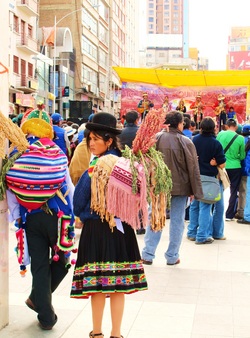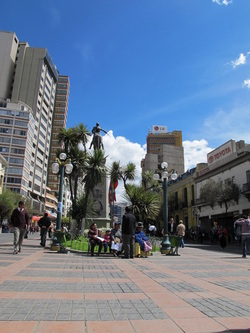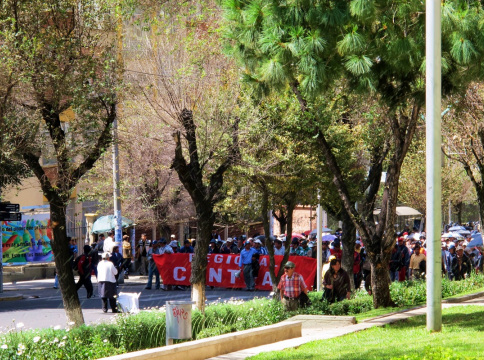And it was easy to write about that. To follow the age-old critique of colonialist/imperialist/orientalist travel. And I don’t mean I did so in a righteous way—in fact is was a matter of accidental convenience, but I ended up challenging those assumptions (and isn’t it Tom Robbins who said “You risked your life, but what else have you ever risked? Have you risked disapproval? Have you ever risked economic security? Have you ever risked a belief? I see nothing particularly courageous about risking one's life. So you lose it, you go to your hero's heaven and everything is milk and honey 'til the end of time. Right? You get your reward and suffer no earthly consequences. That's not courage. Real courage is risking something that might force you to rethink your thoughts and suffer change and stretch consciousness. Real courage is risking one's clichés”?). So I stayed in the Ekko* hostel for two weeks, to get a better ethnographic perspective on the tourism in La Paz (and also to give me time to find a permanent place).
And my fieldnotes are filled with an undertone of “OMG” and “What is wrong with these people?”, but I also met some really amazing people who I respect and at times admire.
And so, amidst emails to tour companies and the Fulbright office, phone calls to friends of friends in La Paz, and no small amount of viewing wrestling, I find myself editing this paper/(hopeful)journal article on tourism and the Cholitas Luchadoars, and just can’t find the voice I want to convey.
I guess that’s always the worry with ethnography. Maybe sometimes you get too close to be critical. Or you can’t find the balance between compassionate writing and dismissing wrongdoings. But I’ll end with a piece of fieldnotes that almost didn’t happen. I went to bed around midnight on Tuesday, and was sleeping peacefully, but around 4:30 some of my young Irish bunkmates wandered into the room, likely on some sort of substance, and talked loudly, turned the lights on and off several times, and giggled themselves to sleep. They giggled me out of my sleep, and when I was still staring at the ceiling at 7am, I decided I might as well go have some free breakfast in the bar instead of continuing to count the cracks.
I had some breakfast, but by 11am was falling asleep while trying to type, so I went back to the room (still containing the sleeping Irish men) for a nap. I woke up just before 1pm, and was starving. I decided to go back to the bar and order some lunch while using the internet there. I was looking for a menu when I noticed that Vijay (an off-duty bartender) had one. I sat down next to him and asked what he was ordering.
“Actually, nothing. We’re going to the factory for Amanda’s birthday.”
I had learned about the factory earlier that week, when Mike, a bartender, was traveling to Cuzco to tend bar there. The factory, according to legend, had the best chicken wings in the world and he was taking about 15 dozen for the staff of Ekko’s sibling hostel there. All week the Ekko staff had been talking about “The Factory” and I pictured some sort of distorted Bolivian Perdue factory where they would sell you wings right off the line or something.
Most of the bar staff at Ekko are travelers much like the patrons of the hostel (and thus of the bar). They simply agree to stay for a minimum of three weeks and tend the bar for four shifts a week in exchange for free housing in a room shared with the other staff, and one free meal per day. Many of them, like Mike start working in the Ekko hostel in one city and then transfer to another Ekko in Peru or Bolivia. Most other travelers stay in the hostel for only a few nights and spend their time at the city’s attractions like biking down the “most dangerous road in the world” (also known simply as “doing death road”) or climbing the Huayna Potosi mountain. I however, was simply trying to make contacts in La Paz, catch up with a few old friends, and start my “real fieldwork,” which meant I was in the hostel a lot more consistently and for a longer stay than most of the other guests. And so, people started recognizing me, talking to me, and I became friends with the bar staff.
So when Vijay suggested I come along, I decided it might be good to get out of the building for a while and spend some time with him and Amanda. So the three of us hopped in a cab headed for Zona Sur, and eventually arrived at The Factory Bar and Grill, which I imagine is somewhat of a Bolivian Buffalo Wild Wings (though I’ve never been to a BWW, so I really can’t make that claim).
But the important part of the story is what happened in the taxi. As we got further into Zona Sur, the upperclass part of La Paz, Vijay said “Being in posh places makes me uncomfortable.” Amanda, who grew up in the UK, concurred and told a story of meeting her family for Christmas in Ecuador (where her extended family lives). She had been backpacking for several months before that. “Its just such a different way to travel.” We stayed in these 5 star hotels where everything was taken care of and took private tours. It felt like being on a safari. Just seeing the world through rose-colored glasses….Then again, we are all staying at Ekko.”
So, I suppose my (initial) conclusion is something like this: The relations between travelers from the “first world” (North America, Western and Central Europe, Australia, New Zealand, urban South Africa) to the people and places they visit in the global south (and yes, I realize the terminology here is highly lacking) are at the very least problematic. However, I don’t think that young people who travel are entirely to blame. Yes, perhaps they are in a way taking advantage of structures that maintain their ability to consume of other “cultures” “people” and possibly most importantly food and alcohol thanks to beneficial exchange rates. But they are also doing so to learn something about the world. They take language classes and volunteer at orphanages. And again, I don’t want to minimize problems of the NGO and volunteer vacation industrial complexes, but they have good intentions. For the most part they are making decisions to experience other places rather than stay in their home country and only read about far off places and people like a new generation of armchair anthropologists. And given that the options for travel tend to be very polarized between five star hotels with private tours, and the more adventure tourism of hostel hopping and death road riding, I find that I have a lot in common with the hostel guests and staff. Even anthropology (gasp!) is not without its colonial and imperial history and undertones. So in a way, we’re all just trying to find a balance of broadening our knowledge, making the world a better place, and working within the structures that are so hard to subvert. Both Amanda and Vijay have moved on to other South American countries now, and I do find myself missing them a bit.
But don’t get me started on the gap years…



 RSS Feed
RSS Feed
